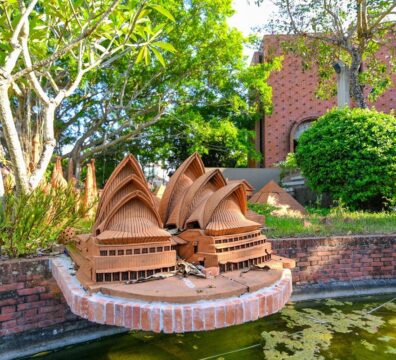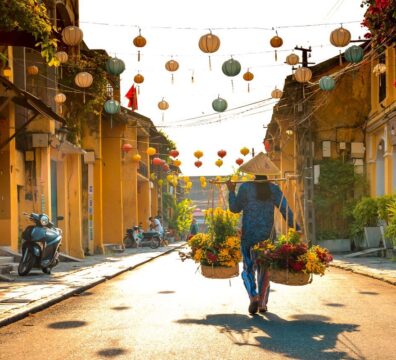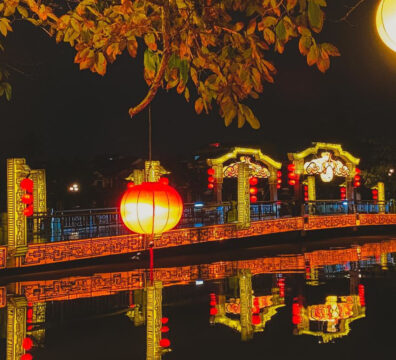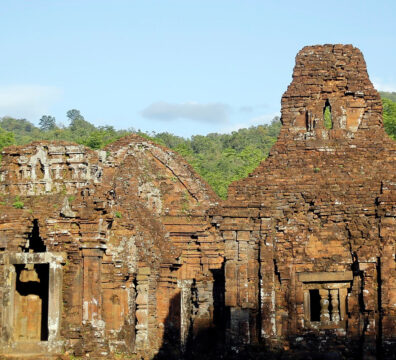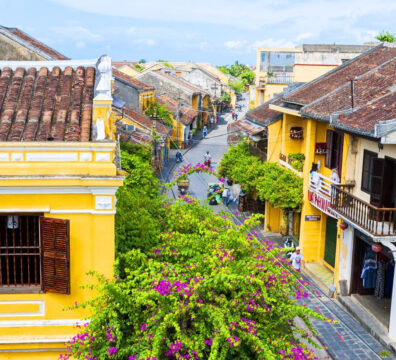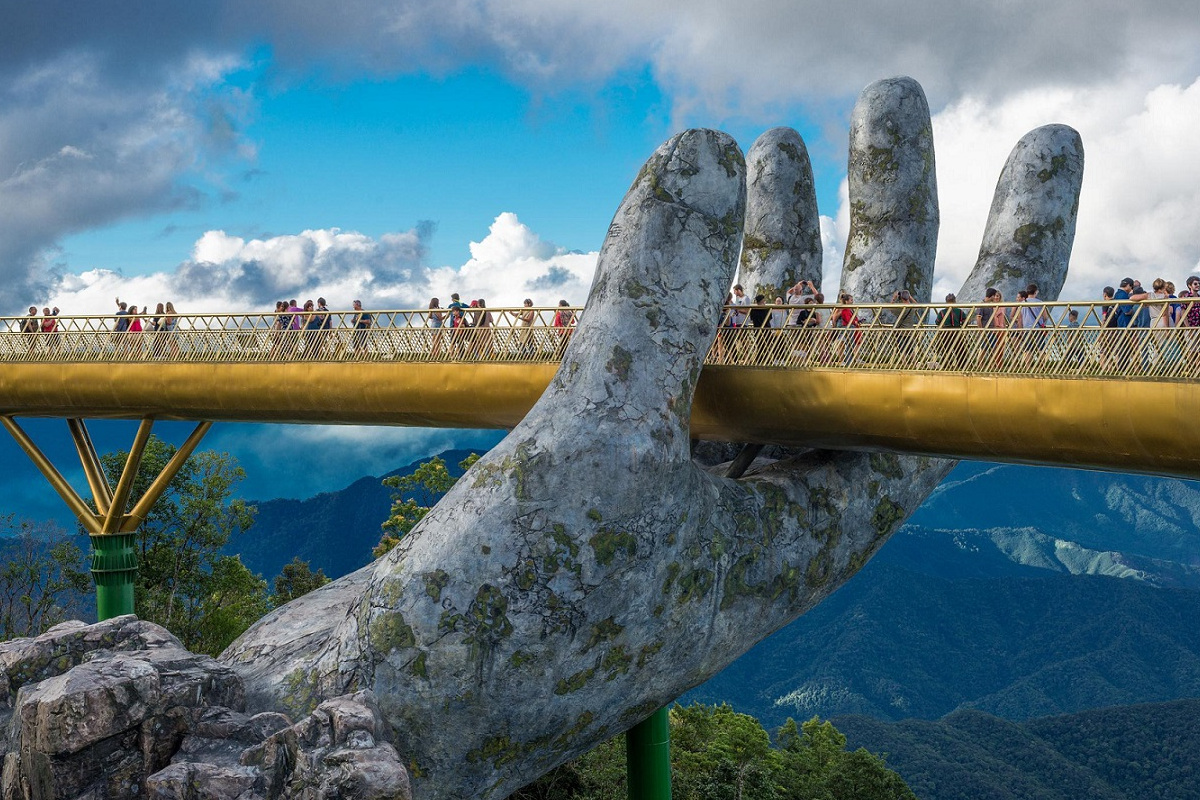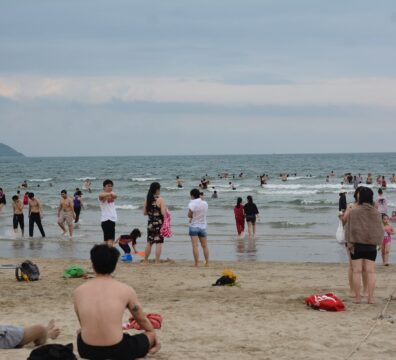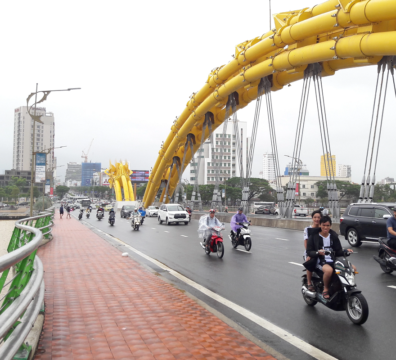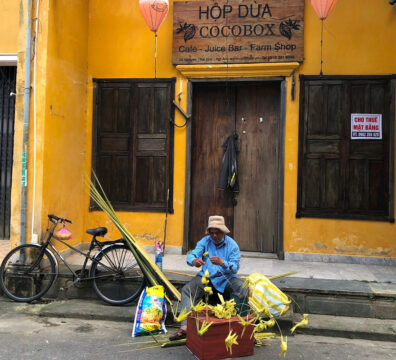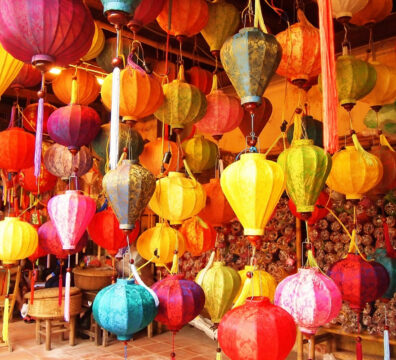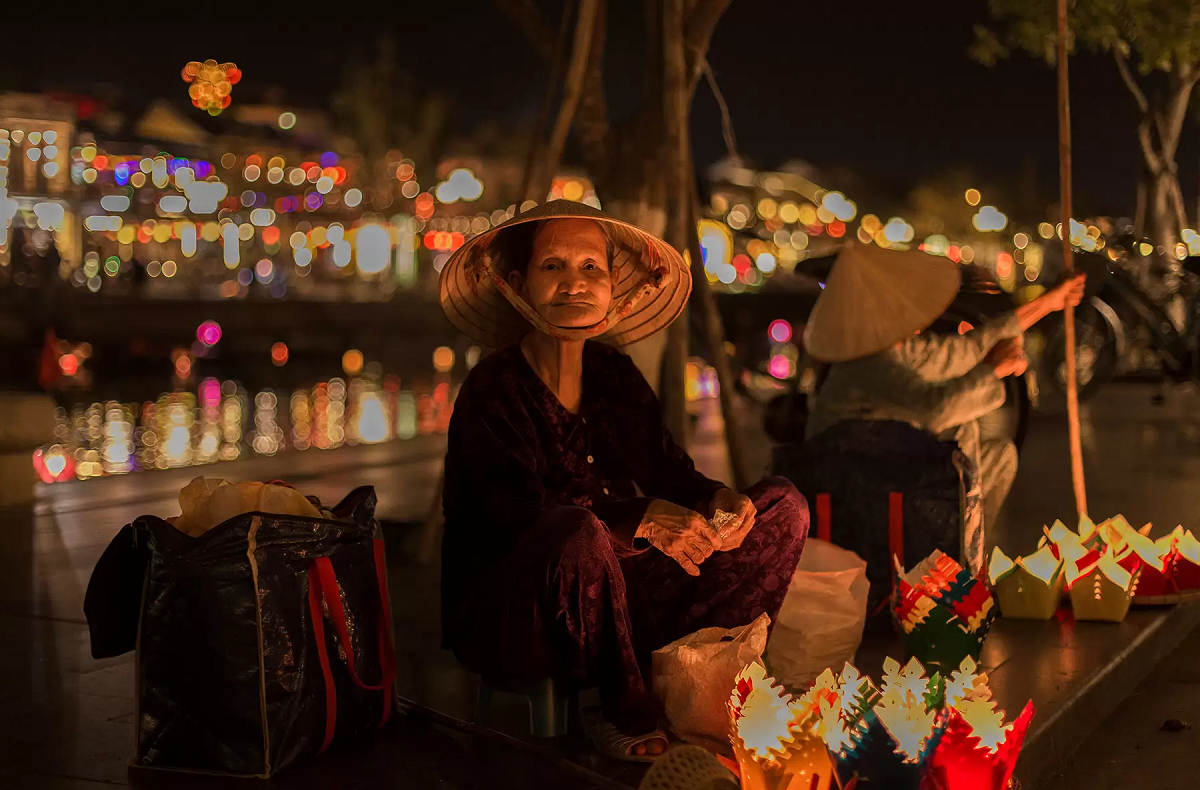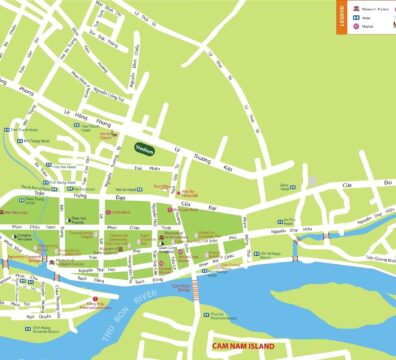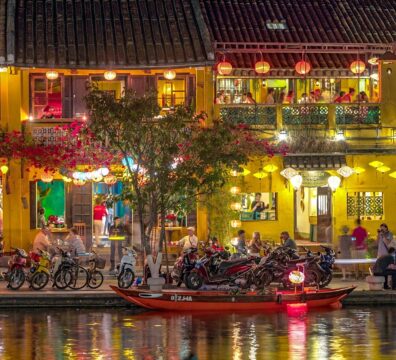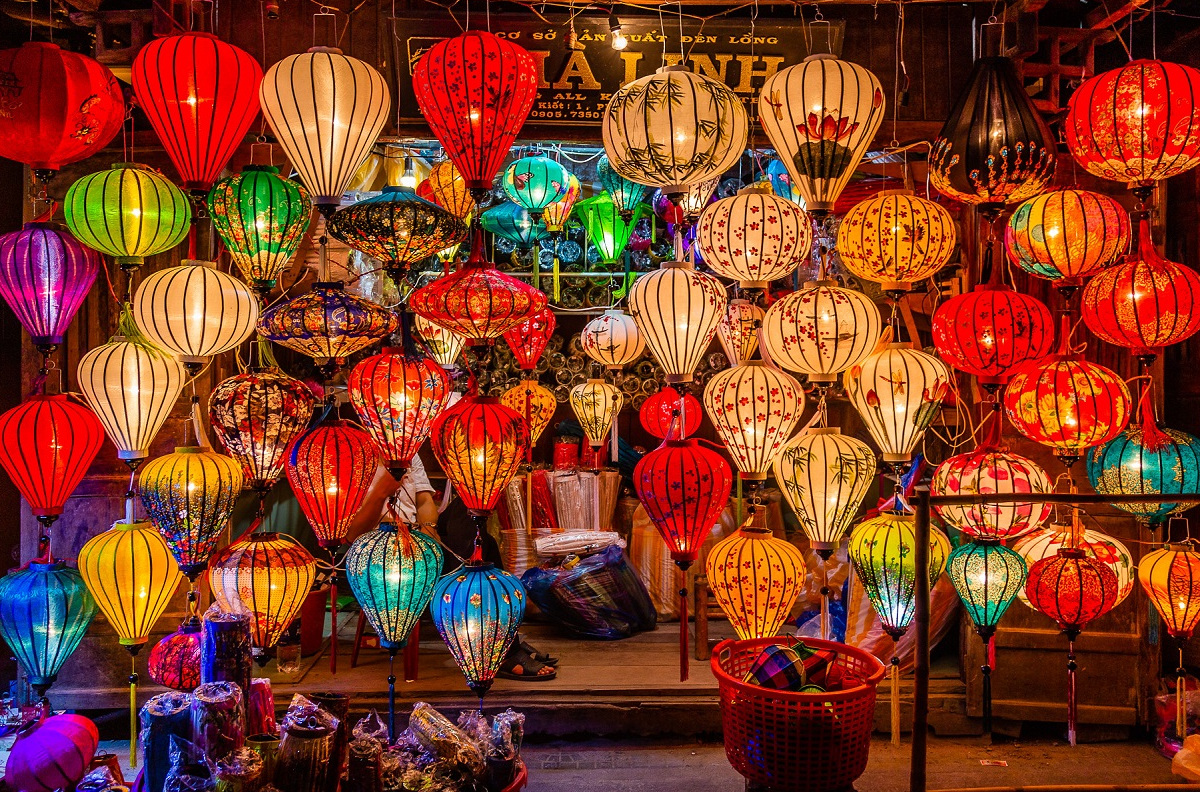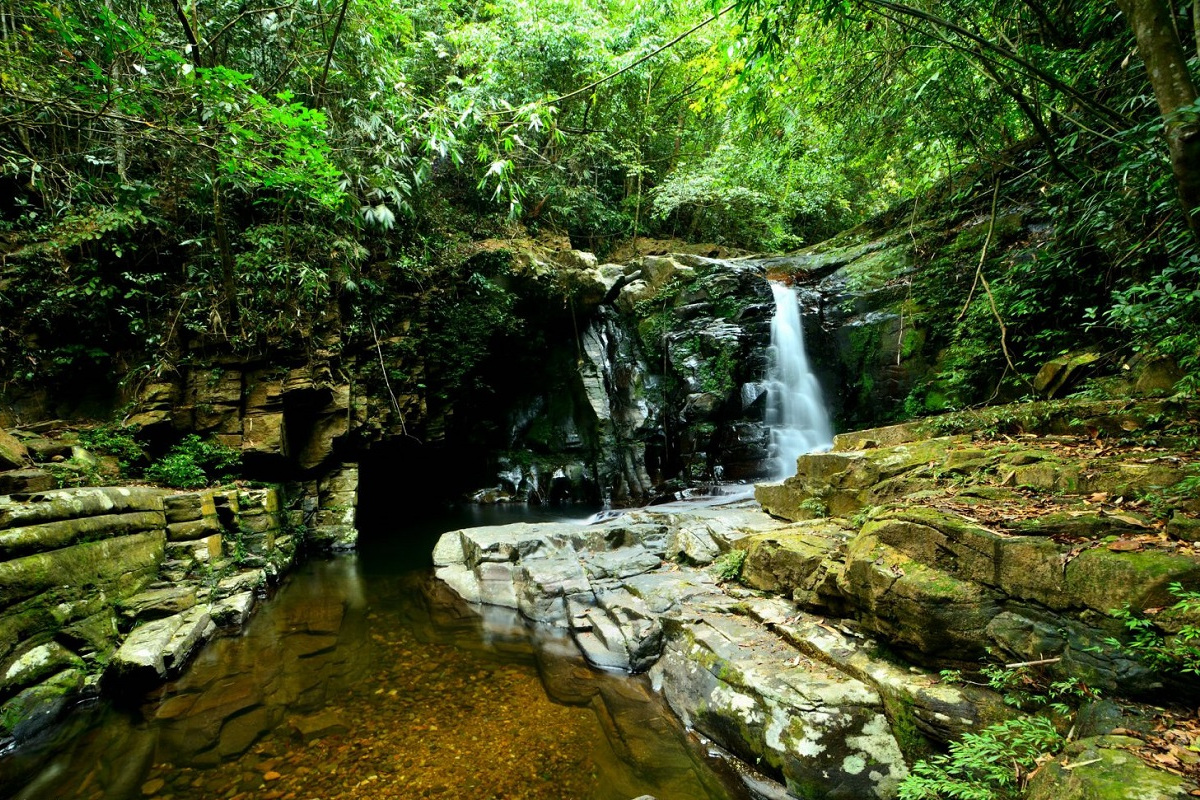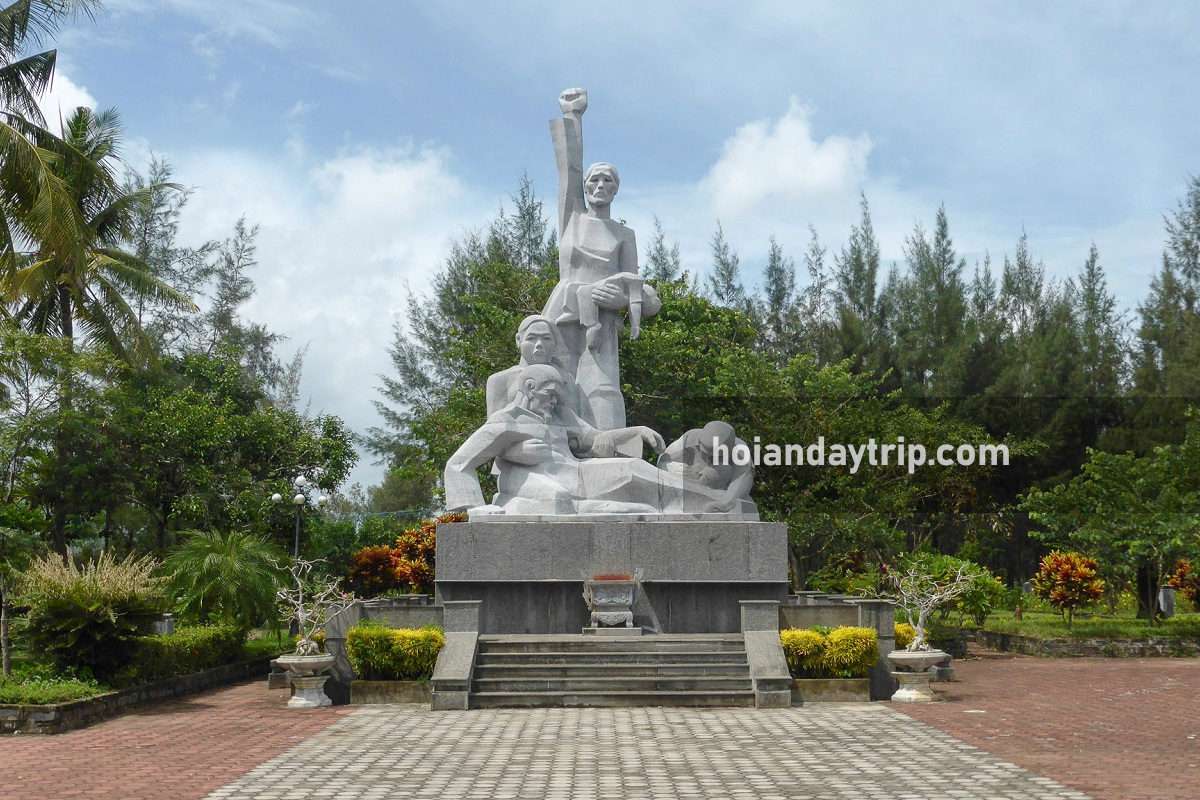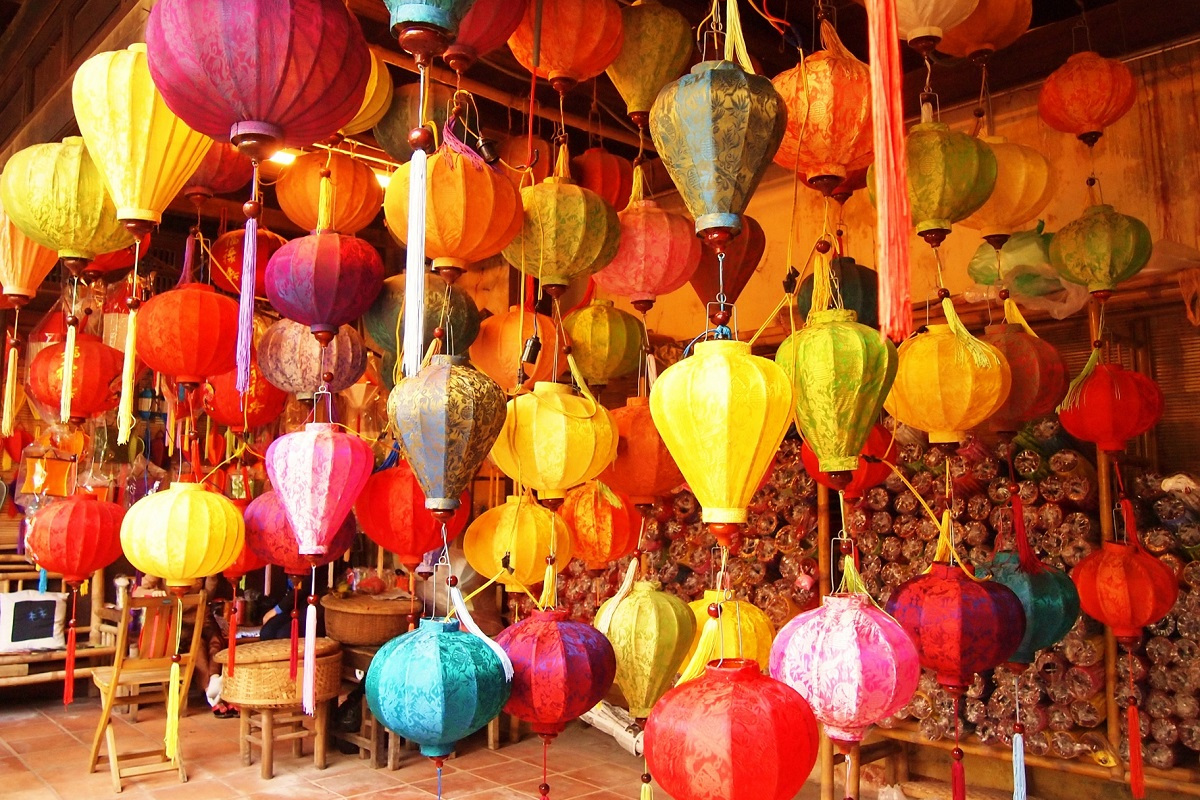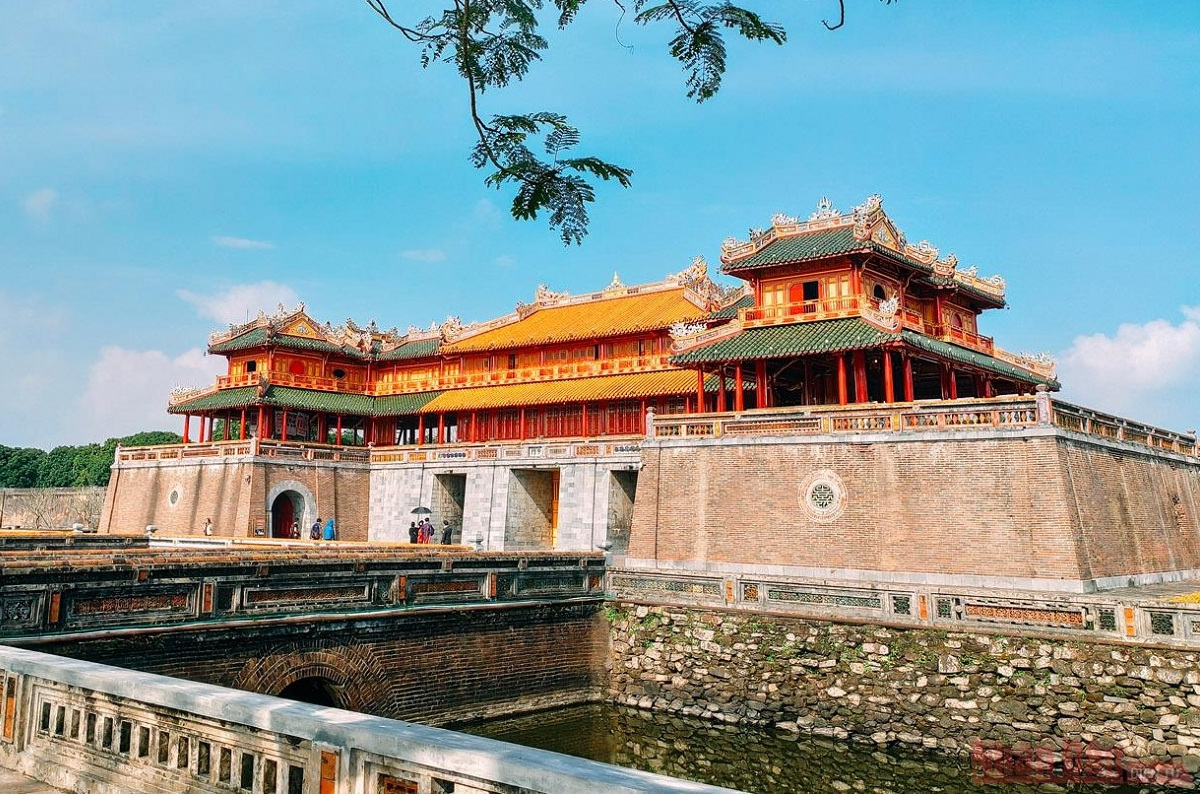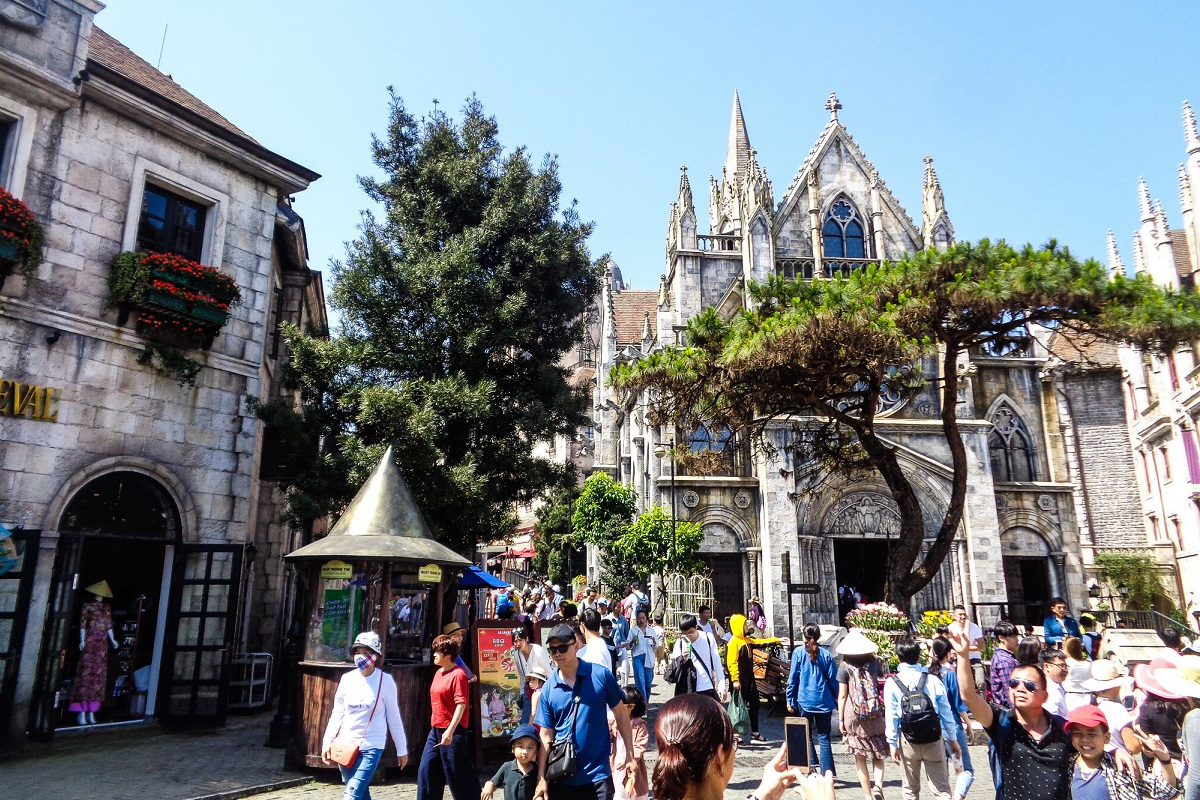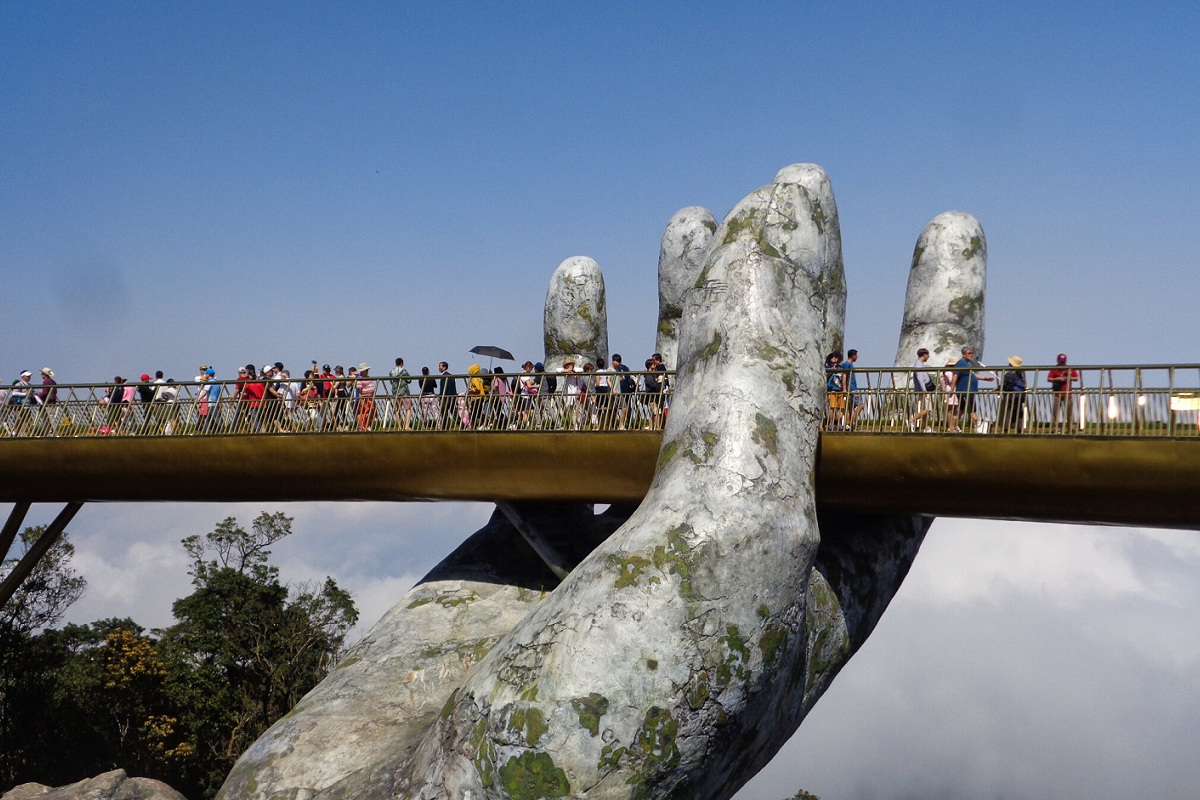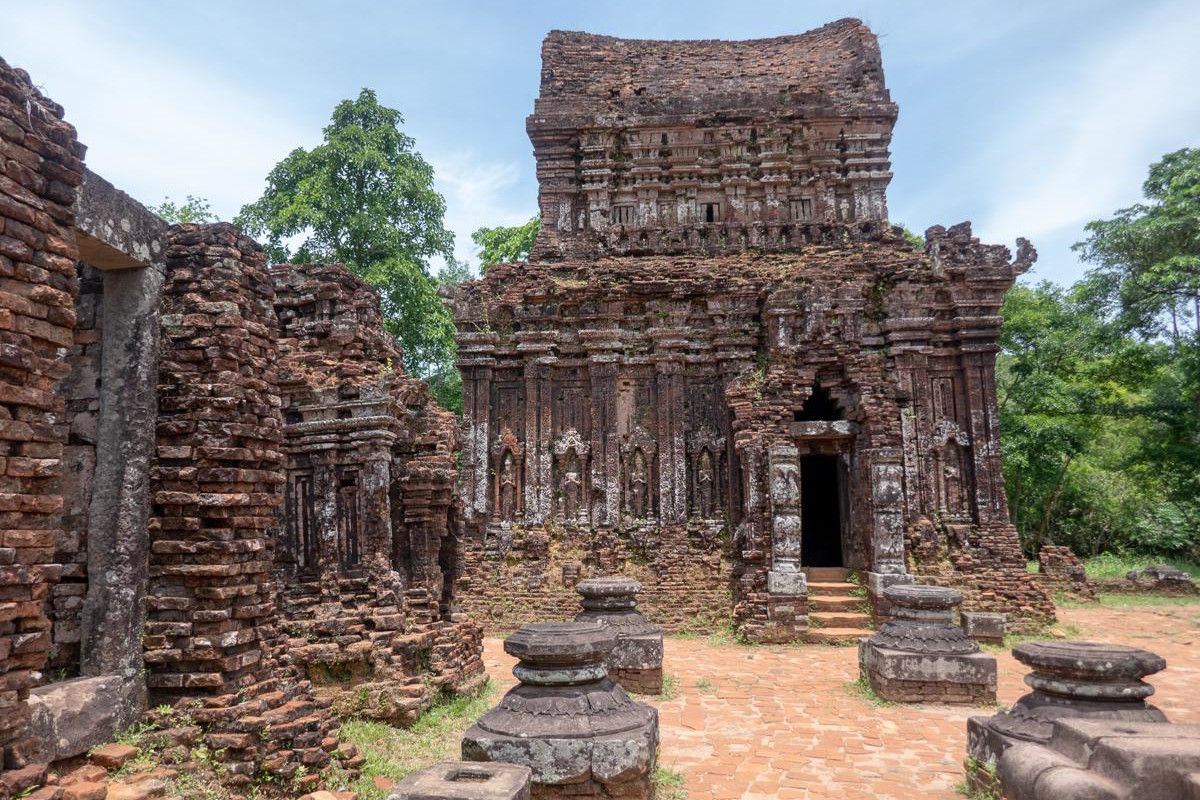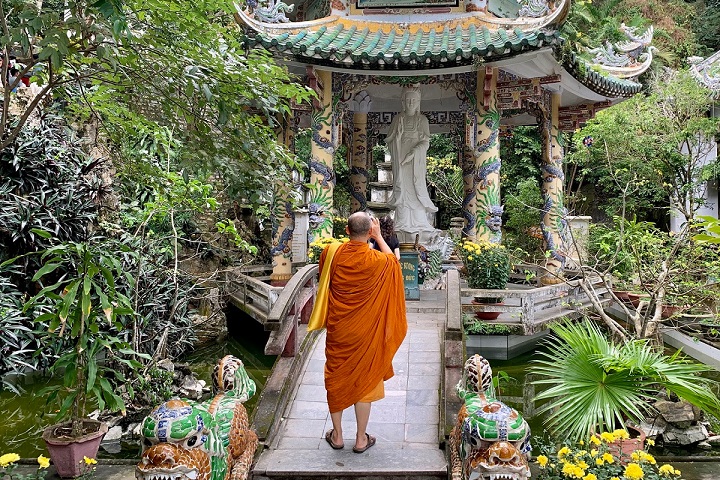As an attraction including attractions, Hoi An Old Town requires an entrance ticket to tourists who come from other parts of Vietnam and the world. It raises funds for preservation of the world heritage as well as its thousands of old buildings. The townies also have financial support when they need, in order to repair their own house or renovate their community’s temples. This article focuses on Hoi An Old Town ticket that all travelers need to have. That is from its price, where to buy, reservation, validity, what it covers to recommendations based on our local knowledge. We recommend reading our guides to Hoi An Old Town and 12 maps to make it easier to explore.
Read also:
- Hoi An Old Town Attractions
- Hoi An Old Town Boats
- 2 Days in Hoi An Itinerary
- 3 Days in Hoi An Itinerary

Table of content
- 1 What and Where is Hoi An Old Town?
- 2 Unesco World Heritage’s Core Zone – The Ticketed Area
- 3 Hoi An Old Town Ticket Price & Reservation
- 4 Places to Buy Hoi An Old Town Ticket
- 5 Opening Times of Ticket Booths
- 6 What does Hoi An Old Town Ticket Cover?
- 7 Hoi An Old Town Ticket Validity
- 8 Recommended Itinerary in Hoi An Old Town
- 9 Hoi An Ancient Town Tour and Private Guide
- 10 Other Entrance Fees in Hoi An
- 11 Hoi An Old Town Ticket Booths
- 12 Related Posts
- 13 Bach Ma National Park: Hiking, Trekking in Da Nang and Hoi An
- 14 Hoi An Wet Season: What to Do in Hoi An When It Rains?
- 15 Thanh Ha Terracotta Park
- 16 Vinwonders Nam Hoi An Theme Park (formerly Vinpearl Nam Hoi An)
- 17 Am Phu Cave (Hell Cave) – Things to Do in Da Nang
- 18 Hoi An or Hue: Which is Better?
- 19 The Official Hoi An Travel Guide (MUST READ)
- 20 The Hoi An Market (Hoi An Central Market) Complete Guide
- 21 Hoi An Memories Show: The Best of Hoi An Impression Theme Park
- 22 Hoi An Bridge: Famous Bridges in Hoi An
- 23 How to Get From Hoi An to My Son Sanctuary
- 24 Hoi An’s Chinese Assembly Halls and Chinese Temples
- 25 Hoi An Walking Tours: Heritage, Foods, Photography & Locals
- 26 Hoi An Self Guided Walking Tour – Hoi An On Your Own
- 27 How to Visit Golden Bridge Vietnam
- 28 Unique Experiences in Hoi An and Why?
- 29 An Bang Beach: A Guide to Hoi An’s Best Beach
- 30 Experiences in Hoi An: Get Insight Into Hoi An’s Local Culture
- 31 Things to Do in Ba Na Hills Besides Golden Bridge
- 32 Hoi An Nightlife: What to Do in Hoi An At Night?
- 33 Hoi An Countryside: Villages, Rice Fields & Tours
- 34 How to Get to Golden Bridge From Hoi An
- 35 Hoi An Entrance Fee: Old Town, Golden Bridge, My Son, More
- 36 Hoi An Airport: Everything You Need to Know
- 37 Hoi An Lantern Boat Ride on Hoai River
- 38 Hoi An Private Car and Driver
- 39 What to Do in Hoi An Ancient Town
- 40 Da Nang and Hoi An Itinerary for Visitors Staying Overnight in Hoi An
- 41 Hoi An 3 Day Itinerary: A Travel Plan for 3 Days in Hoi An
- 42 Hoi An Free Things to Do: Budget Travel in Hoi An Vietnam
- 43 Hoi An One Day Itinerary: A Travel Plan for One Day in Hoi An
- 44 Hoi An Half-Day Tours: Guide to Half Day Trips From Hoi An
- 45 Hoi An Day Tours: A Guide to Best Day Trips From Hoi An
- 46 Hoi An Beach: A Guide to All Beaches in Hoi An Vietnam
- 47 Hoi An Food Specialties
- 48 How to Get From Hoi An to Da Nang
- 49 Hoi An Cheap Things to Do: All Solo Travelers Need to Know
- 50 Hoi An Best Things To Do: Recommendations from Local Experts
- 51 Hoi An Things to Do: All What Can You Do in Hoi An Vietnam
- 52 Hoi An Things Not to Miss: A Guide to Must Do in Hoi An
- 53 Hoi An or Da Nang: Which is Better for First Time Visitor?
- 54 Hoi An Pottery Village: A Guide to Thanh Ha Pottery Village
- 55 Hoi An Ancient Town Tour
- 56 Hoi An Old Town Ticket: Price, Sellers, Included Sites, More
- 57 My Son Sanctuary Tour
- 58 Hoi An Lanterns: Festival, Making Class, Where to Buy, More
- 59 Hoi An Best Area to Stay: Guide to Where to Stay in Hoi An
- 60 Hoi An Weather by Month: Guide to Hoi An Monthly Weather
- 61 Hoi An River Cruise: Guide to The Best Boat Tour in Hoi An
- 62 Hoi An Old Town Boats: Guide to Boat Rides in Hoi An Town
- 63 Hoi An 2 Day Itinerary: Traveler Guide to 2 Days in Hoi An
- 64 Cham Island Hoi An
- 65 Hoi An Basket Boat Ride
- 66 Hoi An Coconut Village: A Guide to Cam Thanh Coconut Village
- 67 Hoi An Cham Temples: My Son Sanctuary & Quang Nam Temples
- 68 How to Get from Da Nang Airport to Hoi An
- 69 Da Nang to Hoi An: Best Da Nang Airport Transfer and More
- 70 Hoi An Tour Guide: How to Find a Private Tour Guide in Hoi An
- 71 Hoi An Ancient Town Attractions
- 72 Hoi An Old Town Map
- 73 Tra Que Vegetable Village
- 74 Guide to Hoi An Lantern Festival – Hoi An Full Moon Festival
- 75 Hoi An Night Market: A Thing to Do in Hoi An at Night
- 76 My Son Sanctuary Travel Guide
- 77 Hoi An Old Town Unesco World Heritage – Hoi An Travel Guide
- 78 Featured Experiences and Tours
- 78.0.1 Bach Ma National Park Tour from Hue
- 78.0.2 Bach Ma National Park Tour from Da Nang/Hoi An
- 78.0.3 Hoi An Sunrise Fish Market Tour
- 78.0.4 My Lai Massacre Tour
- 78.0.5 Golden Bridge/Ba Na Hills & Hoi An Tour
- 78.0.6 Hoi An Instagram Tour
- 78.0.7 Ky Anh Tunnel & Tam Thanh Mural Village Tour
- 78.0.8 Da Nang to Hue Motorbike Tour with Hai Van Pass & Easy Rider (1 Way)
- 78.0.9 Hue to Da Nang Motorbike Tour with Hai Van Pass & Easy Ride (1 Way)
- 78.0.10 Hue to Hoi An Motorbike Tour with Hai Van Pass & Easy Rider (1 Way)
- 78.0.11 Hoi An to Hue Motorbike Tour with Hai Van Pass & Easy Rider (1 Way)
- 78.0.12 Tra Que Vegetable Village Tour with Cooking Class
- 78.0.13 Ba Na Hills Half Day Tour from Hoi An
- 78.0.14 Marble Mountain & Hoi An Day Tour from Da Nang Port
- 78.0.15 Hue Day Tour from Chan May Port with Lunch
- 78.0.16 Marble Mountain & Hoi An Tour from Chan May Port
- 78.0.17 Ba Na Hills/Golden Bridge Tour from Da Nang Port
- 78.0.18 Ba Na Hills/Golden Bridge Tour from Chan May Port
- 78.0.19 Golden Bridge Private Tour with Ba Na Hills & Lunch
- 78.0.20 Ba Na Hills Afternoon Tour with Golden Hands Bridge
- 78.0.21 Ba Na Hills Private Tour with Golden Hands Bridge
- 78.0.22 Ba Na Hills Half Day Tour with Golden Bridge
- 78.0.23 Ba Na Hills Early Morning Tour to Beat the Crowds
- 78.0.24 Golden Bridge and Ba Na Hills Night Tour
- 78.0.25 Golden Hands Bridge Tour In Sunrise or Sunset (1/2 Day)
- 78.0.26 Cam Kim Island Bicycle Tour From Hoi An
- 78.0.27 Cham Island Tour From Hoi An (Group Tour)
- 78.0.28 Cham Island Tour From Da Nang (Group Tour)
- 78.0.29 Hoi An Vegetarian Food Tour
- 78.0.30 Hoi An Evening Walking Food Tour with Local Foodie
- 78.0.31 Private Hoi An Basket Boat Tour (Shuttle Bus, Bicycle, Bike)
- 78.0.32 Half-day Am Phu Cave Tour (Private)
- 78.0.33 Hoi An Countryside Tour by Electric Car or Bike
- 78.0.34 Da Nang Tour Package From Singapore
- 78.0.35 Hoi An Evening Tour From Da Nang with Lantern Boat Ride
- 78.0.36 Hoi An Walking Food Tour Through Laneways
- 78.0.37 My Son Sanctuary and Hoi An Old Town Tour
- 78.0.38 My Son Day Trip From Hoi An including Marble Mountains and Basket Boat
- 78.0.39 Half Day Hoi An City Tour With River Cruise
- 78.0.40 Son Tra Peninsula Tour with Marble Mountains (Private/Small Group)
- 78.0.41 Hue Day Trip From Hoi An with Hai Van Pass, River Cruise & Lunch
- 78.0.42 Hoi An Ancient Town and Countryside Tour (Bests of Hoi An Tour)
- 78.0.43 Hoi An Tour From Da Nang Airport (Private, Optional Lunch)
- 78.0.44 Hoi An Day Trip From Da Nang (Marble Mountains, Basket Boat, Old Town)
- 78.0.45 Da Nang City Tour From Airport (Private, Optional Lunch)
- 78.0.46 Hoi An City Tour with Lantern Class, Lantern Boat, Night Market & Local Food Sampling
- 78.0.47 Marble Mountains, Basket Boat Ride & Hoi An Old Town Walking Tour
- 78.0.48 Marble Mountains & Golden Bridge/Ba Na Hills Day Tour
- 78.0.49 Marble Mountains & Monkey Mountain Tour (Half-day, Private)
- 78.0.50 Private Golden Bridge Sunrise Tour (Half-day, Optional Lunch)
What and Where is Hoi An Old Town?
Hoi An Old Town is a world heritage site in the heart of Hoi An city, by the estuary of Thu Bon River – the largest waterway of the province. It’s located 30 km south of Da Nang and its airport where many flights from inside and outside of Vietnam land. Find out your best transport between these cities in our guide to how to get from Da Nang to Hoi An (and vice versa). 75 km away, travelers by air can choose to fly to Chu Lai airport – the south gateway.
Historically, the Chams (people) paved the way for growth of commerce in this trade port when they attracted merchants from other countries to exchange goods. From 15th to 19th centuries, Viet people handed over and their land rulers encouraged international trading. That’s why Hoi An (Faifoo by Europeans) was a major stopover for merchants in South-east Asia. Silk, spices, porcelain and handicraft products are what they seek. Due to some reasons, its prosperity gradually lost in 19th century and Da Nang took its role. See everything in our guide to Hoi An Old Town.

Unesco World Heritage’s Core Zone – The Ticketed Area
Boundaries
Core zone (the best-preserved zone) of Hoi An Old Town world heritage has an area of 30 hectares. This zone is strictly protected and bordered by Thu Bon River to the south and 3 roads closewise: Cao Hong Lanh, Phan Chu Trinh and Hoang Dieu. For Unesco, all of remains within it fully expresses the intactness and the role of the town as an international trade port. There are grid streets lined by traditional residential and shop houses, a bridge, still-active markets, a quay where merchant boats moor and religious buildings constructed by different nationalities. Architecture here showcases a unique fusion of Asian cultures and a little bit French. See detailed boundaries in Hoi An Old Town Map
How to Preserve Hoi An Ancient Town
Hoi An Ancient Town’s streets and laneways are unallowed for access to vehicles with 4 wheels and more. Motorcycles can’t move in the area during pedestrian hours too, from 9 to 11 a.m and 5 to 9 p.m daily. This policy aims to reduce air pollution, noise and dangers for walkers. So, walking and riding bicycles are the best ways to get around.
Buildings in Hoi An Ancient Town are classified into 5 categories, based on their own history, culture, architecture, state of preservation and more. Each one receives a different policy from the local government. There are special, I, II, III, IV and V. The bulk of special buildings open the doors for tourists and require a ticket, because of their unreplaceable values. No doubt that Japanese bridge, Chinese assembly halls and temples, old Vietnamese houses, communal houses and family chapels are in this list. The lowest categories are buildings constructed before the town was designated to be a heritage site. Conservationists request to replace them by a new one with traditional architectural styles, like tiled roof, yellow wall, timber furniture.

Hoi An Old Town Ticket Price & Reservation
Hoi An Old Town Ticket Price
At the moment, the price of a Hoi An Old Town ticket (or Hoi An Ancient Town entrance fee) is 150,000 VND for international visitors and 80,000 VND for domestic visitors. Overseas Vietnamese (Viet kieu) have to show Vietnamese ID or passport if wanting to pay the same to locals. It’s free of charge for kids and childrens will get a discount. The rate for non-Vietnamese sightseers is higher because of more coverings and longer validity.
In 2022, visitors only pay a half of original Hoi An Old Town ticket price, 75,000 VND for foreigners and 40,000 VND for Vietnamese.
Reservation and Tips
At this time, visitors don’t need or can not reserve Hoi An Old Town ticket in advance. Just come to ticket booths (see the list below) and purchase. Keep in mind to take a map to know the location of places with highlights. Whenever aiming to wander around the town, like in the evening to see lanterns, don’t forget the ticket because it’s a must. If bought but leave it in the room, showing the map taken from the ticket kiosks or pictures of what you took in ticket-required places.

Places to Buy Hoi An Old Town Ticket
Ticket booths are placed along boundaries of the Unesco world heritage area. For visitor’s convenience, these official selling spots stand by main roads leading further inside the best-protected quarters. Some places are located in the heart of the town, to allow visitors who walk in by laneways to pay the admission easier. Location of all booths is outlined clockwise from the south as following below:
– An Hoi Bridge: Nguyen Phuc Chu/Chau Thuong Van crossroad
– Cong Nu Ngoc Hoa/Nguyen Du crossroad
– Cao Hong Lanh: near the beginning of Cong Nu Ngoc Hoa and Nguyen Thi Minh Khai streets
– The Japanese Bridge Laneway: near crossroad with Phan Chu Trinh St
– Japanese Covered Bridge: Tran Phu/Bach Dang crossroad
– Gate of Ba Mu Temple on Hai Ba Trung St
– Le Loi/Phan Chu Trinh crossroad: Dinh Ong Voi communal house (Hoi An communal house)
– Le Loi/Tran Phu crossroad: first quarter
– Nguyen Hue/Phan Chu Trinh crossroad
– Hoang Dieu/Tran Phu crossroad: near Hainan assembly hall

Opening Times of Ticket Booths
Ticket booths in Hoi An Old Town open from 7 a.m to 9 p.m. Due to low domestic tourists, many of which close around 6 p.m when the bulk of ticketed attractions stop welcoming visitors. The cashier knows English, so he/she definitely can talk with and give some recommendations on the map. Let her/him know if wanting to book an on-site guide around the town. However, we recommend traveling with a guide who doesn’t work for the management board. The reason is that this “unofficial” buddy will wander with visitors longer, speak English better and knowledgeable equally, but not more expensive.
What does Hoi An Old Town Ticket Cover?
Hoi An old town ticket covers the entry to the Unesco-inscribed area anytime during the day. In addition, ticket holders can choose to see 5 amongst 21 sightseeing places and art performance theatres. To the right-hand part of the ticket, there are 5 blocks with words “sightseeing places”. In each attraction, the checker will use a scissor to cut a block and if all are cut, visitors need to buy another ticket if would like to sightsee more.
List of Places Included by Hoi An Old Town Ticket
– Japanese Covered Bridge (Chùa Cầu): This is the town’s emblem, built by the Japanese in the early 17th century in 2 years, from the Year of Monkey to the Year of Dog. It’s constructed by the Chinese later and since then, a Taoist temple has been standing behind. Both groups of people wish for moderate weather, luck in business and happiness. Together with the use of local materials and artisans, the bridge becomes a symbol of cultural exchange between 3 countries. You can see it on the note of 20,000 VND.
– Hoi An Traditional Art Performance House: At 66 Bach Dang St, this theatre provides shows performed by artists, at 10:15 a.m, 3:15 p.m and 4:15 p.m.
– Vietnamese Old Houses (nhà cổ): allow visitors to know better local resilience in many past centuries, and life of the owners. Tan Ky, Duc An, Phung Hung and Quan Thang are the 4 most famous houses.
– Chinese Assembly Halls: showcase the most sophisticated architectures in town that express the wealth of different Chinese groups. The people migrated here due to political and business reasons. Jujian (Phúc Kiến) and Guangdong (Quảng Đông) are most visited, and then Chaozhou (Triều Châu), Hainan (Hải Nam) and All Communities (Trung Hoa).
– Museums: exhibit in a variety of collections that tell visitors different stories about history and culture in town. There are museums for Sa Huỳnh culture, Trade ceramics, Folk culture, Traditional medicine and History and culture.
– Temples and Pagodas: Quan Cong temple where Chinese honour the military general of the same name and visit daily to pray. Vietnamese Buddhist pagoda Quan Âm stands next to.
– Family Chapels: a place of worship for Vietnamese family’s ancestors, including the Nguyễn Tường, Trần.
– Communal Houses: worshipping centers of villages in Vietnam, including Cẩm Phô and Hội An built by Vietnamese and Tụy Tiên Đường by Chinese in Minh Hương village.
Our Choices for the First Ticket
These are 5 places we recommend for the first time in Hoi An Old Town and reasons:
– Japanese Covered Bridge: emblem of the town, only Japanese building, stunning history and cultural relations, a must-know photogenic spot
– Fujian Assembly Hall: largest of its kind, many awesome architectures, an Instagrammable spot
– Museum of Trade Ceramics: exhibiting a part of ceramics and porcelains brought from the largest underwater excavation – Hoi An shipwreck
– Old House of Tan Ky: one of the best-protected old merchant residence in town, free guidance from a member of the owner family, food levels over years
– Hoi An Traditional Art Performance House: only choice for “watching” instead of sightseeing, attractive Tuong show
Our Choices for the Second Ticket (Repeat Visitors)
– Museum of Folklore: providing information and artifacts about many cultural traditions and handicrafts of the town, like tailoring, weaving, pottery making
– Guangdong Assembly Hall: near Japanese bridge and contains the finest architectures and cultural values of one of the largest Chinese communities, also sacred to Vietnamese
– Duc An Old House: owned by Mr Cao Hong Lanh who founded the first communist association for the youth in town, ever functioning as a bookstore, medicine store.
– Quan Cong Temple: built by Chinese merchants in the front of the market to pray for luck in the business, for worship of Quan Cong – a famed military general in ancient times.
– Tran Family Chapel: most-loved of its kind, thanks to ornate interiors and shaded garden in the surrounding.
Free Places that Visitors Can’t Miss
– Hoi An Central Market: an array of local food stalls with a fixed, clear price and hospitality, all Hoi An’s special dishes can be found here
– Gates of Ba Mu Temple: an emerging instagrammable spot, newly-reconstructed main gate of Chinese Ba Mu Temple that destroyed by wars
– Precious Heritage by Rehann: owned and showcase art photo works of Rehann – a French expat in Hoi An, a collection of every traditional costume of ethnics in the country
– Hoi An Night Market: including over 150 food and souvenir stalls where visitors can try lots of yummy dishes, specialties, and take amazing pictures with lanterns
– Bach Dang waterfront for sunset
– Bai Choi stage where folk games and performances occur every night, registered by Unesco in 2017


Hoi An Old Town Ticket Validity
Validity of Hoi An old town ticket is one day that is clearly shown on the physical piece of ticket. However, aiming to provide a convenience and comfort at most for international visitors, the city decides to extend it to cover the whole stay of the buyers. Simply, the ticket validates until you leave Hoi An. Always remember to bring it, to enter the town if you don’t want to purchase another one.
Recommended Itinerary in Hoi An Old Town
The Morning Itinerary
– See daily life of locals in the Fish market, a part of Chợ Hội An (the Central Market)
– Breakfast and morning coffee like a local in Japanese Covered Bridge
– Sightsee our 5 old constructions and watch the cultural show
– Visit a good tailor shop for a custom made garment like suit, shirt, dress
– Try Nước mót (local herb water) in front of Duc An House
– Go to the Central Market to try cao lau, the signature noodle dish of the town or Banh Mi Phuong to eat the best banh mi sandwich.
The Afternoon Itinerary
– Sightsee 4 places and the theatre to watch the traditional art show
– Visit a tailor shop for personalized garments at your own favourite styles
– Have a break in a coffee shop and sip Vietnamese traditional coffees such as ca phe sua da or coconut milk coffee
– Enjoy the sunset at Bach Dang waterfront (get a drink if like!)
– Taste street foods like bánh ướt thịt nướng (grilled pork skewers rolled with rice paper, raw vegetables and eat with peanut sauce)
– Stroll along the Night market to sample more and photograph with lanterns
– Get on a lantern boat ride, light up a paper lantern and drop it down the water by yourself
– Have a cocktail or cold beer in the Pub Street

Hoi An Ancient Town Tour and Private Guide
Main article: Hoi An Ancient Town Tour
Half day Hoi An ancient town walking tour is the most popular activity, for both guided and self-guided travelers. Its itinerary has all places included in the ticket, and other recommendations from the tour guide. The additions may be tailors, coffee shops, markets, handicraft workshops, and more that allow visitors to fully know the town. In the afternoon, the chance to see street foods is high, and he/she definitely suggests (and informs) to give it a try. Food tours or cooking tours are other stunning experiences with a focus on local diverse cuisine. On the other hand, all day tours from Hue or Da Nang to Hoi An include the Old Town, because it’s a must see. If staying overnight in Hoi An already, travelers can choose to combine with some top attractions in the outskirts such as My Son temples or Marble Mountains, to complete the day.

Other Entrance Fees in Hoi An
– Hoi An Pottery Village Entrance Fee: 35,000 VND covering entry to the village, class to learn about how to make pottery, a gift (clay whistle) and visiting historical buildings. Within it, Thanh Ha Terracotta Park costs, separately, 40,000 VND.
– Hoi An Coconut Forest Entrance Fee: 30,000 VND, covering entry to Bay Mau coconut village to explore its maze-like waterways by a basket boat.
– Cham Island Entrance Fee: 70,000 VND
– Tra Que Vegetable Village Entrance Fee: 35,000 VND
– My Son Sanctuary Entrance Fee: 150,000 VND, covering entry to all temples and ruins, two-ways transfer by buggy, Cham show, and entry to My Son Museum.

Hoi An Old Town Ticket Booths
Related Posts
Bach Ma National Park: Hiking, Trekking in Da Nang and Hoi An
Two best places for trekking and hiking in and near Da Nang are Son Tra mountain (peninsula) and Bach Ma national park. Which one is better is actually personal because these
Hoi An Wet Season: What to Do in Hoi An When It Rains?
No beach, no pool, no outdoor adventures? What to do in Hoi An when it rains? This is a very popular question from travelers who come to Vietnam in the
Thanh Ha Terracotta Park
Between 15th and 19th centuries, Hoi An was one of major stopovers for sailing merchants to trade in Southeast Asia. Meanwhile, craftspeople in its Thanh Ha village produce high-quality pottery
Vinwonders Nam Hoi An Theme Park (formerly Vinpearl Nam Hoi An)
In addition to historical and cultural attractions, nowadays Hoi An also has a couple of amusement parks to entertain. Definitely, they’re ideal places for families with children and groups of
Am Phu Cave (Hell Cave) – Things to Do in Da Nang
Although in the Marble mountains – the most visited attraction in Da Nang, travelers often miss Am Phu cave. One of reasons is that it’s mentioned much online and not
Hoi An or Hue: Which is Better?
Both Hoi An and Hue cities are in the middle of Vietnam, and they’re not far from each other (about 130 km). Therefore, for those who travel from north to
The Official Hoi An Travel Guide (MUST READ)
By the estuary of Thu Bon river, Hoi An is one of the best places to visit in Vietnam. This Vietnamese town is a package for travelers – a pretty
The Hoi An Market (Hoi An Central Market) Complete Guide
The Hoi An Market is the first market in Hoi An ever. Over centuries, it’s still the largest market in town although the town has a much bigger size than
Hoi An Memories Show: The Best of Hoi An Impression Theme Park
The Hoi An Memories Show is a famous series of outdoor performances in Hoi An at the present time. Thanks to its exceptional production and great cultural stories, it becomes
Hoi An Bridge: Famous Bridges in Hoi An
Hoi An has many bridges because it’s located at the confluence of 3 rivers: Thu Bon river, De Vong river and Truong Giang “Long river”. The distributaries of these rivers
How to Get From Hoi An to My Son Sanctuary
My Son sanctuary is one of the most popular places to visit for tourists staying overnight in Hoi An, especially those who spend many days there. It’s known for a
Hoi An’s Chinese Assembly Halls and Chinese Temples
Chinese people migrated to Hoi An from the early 17th century. Today, Chinese communities as a whole are the second most important piece to form the town’s unique culture. The foremost
Hoi An Walking Tours: Heritage, Foods, Photography & Locals
Strolling around heritage quarters with a local guide is the activity that so many travelers love to do in Hoi An. It enriches their time in this lovely town. Firstly,
Hoi An Self Guided Walking Tour – Hoi An On Your Own
Hoi An old town is friendly for pedestrians, especially during the time that motorized vehicles (scooters, cars, etc) are prohibited to move around its heritage quarters. That is safe for
How to Visit Golden Bridge Vietnam
The Golden Hand Bridge of Ba Na hills today is a dream place to visit for many travelers. Since it opened in June 2018, millions of people have set their
Unique Experiences in Hoi An and Why?
Today, travelers seek more experiences in the destination they go to. They want to have a deeper understanding about the culture of local people and interact with them. No other
An Bang Beach: A Guide to Hoi An’s Best Beach
An Bang beach now becomes a popular tourist attraction in Hoi An. It may be the best known and most convenient to reach from the town’s centre. Not only tourists,
Experiences in Hoi An: Get Insight Into Hoi An’s Local Culture
As the most unique Vietnamese town, Hoi An is definitely worth visiting. Here, visitors have many things to do and experiences for their holiday time. Everyone knows that it has
Things to Do in Ba Na Hills Besides Golden Bridge
According to local authorities, 50% of visitors coming to Da Nang and Hoi An visit the Ba Na hills. In other words, that is nearly 10 millions of people. This
Hoi An Nightlife: What to Do in Hoi An At Night?
After dark, Hoi An becomes exceptionally spectacular. If planning to stay overnight or visiting this ancient heritage town, at least travelers know that it’s “decorated” by so many colorful lanterns.
Hoi An Countryside: Villages, Rice Fields & Tours
By the coast, Hoi An is at the confluence of 3 rivers: Thu Bon river, Truong Giang river and De Vong river. This economically strategic location has supported trading activities
How to Get to Golden Bridge From Hoi An
There are many travelers visiting the Golden bridge from Hoi An. Both the bridge and the town today are must-see places in the region, so staying overnight in the town
Hoi An Entrance Fee: Old Town, Golden Bridge, My Son, More
Are you planning to visit Hoi An? And you don’t know how much cash you need to prepare for visiting places? This article lists tourist attractions in Hoi An and
Hoi An Airport: Everything You Need to Know
Hoi An is a famous tourist city in Vietnam. It’s 800 kilometers away from Hanoi, the capital of Vietnam and nearly 1,000 kilometers from Ho Chi Minh city, the biggest
Hoi An Lantern Boat Ride on Hoai River
A lantern boat ride is a thing to do that visitors must do today in Hoi An. For many centuries, locals have taken it on the Hoai river by the
Hoi An Private Car and Driver
Hoi An is one of the most popular tourist destinations in Vietnam. In the busiest year, it attracts about 9 millions visitors who come to enjoy its charming beauty, rich
What to Do in Hoi An Ancient Town
Hoi An Ancient Town is a must see, not only thanks to its world heritage title, but also to its vintage urban landscape, lots of attractions and activities. In the
Da Nang and Hoi An Itinerary for Visitors Staying Overnight in Hoi An
Da Nang and Hoi An are twin cities in the heart of Central Vietnam. Both are popular tourist destinations for either domestic or international visitors, and share many similarities. Due
Hoi An 3 Day Itinerary: A Travel Plan for 3 Days in Hoi An
3 days are a perfect duration to stay overnight in Hoi An and explore captivating places in and around it. Especially for those who travel from city to city or
Hoi An Free Things to Do: Budget Travel in Hoi An Vietnam
Travelers should know free things to do in Hoi An, to save the budget for this wonderful city and by that, can stay longer to explore. From old town, countryside
Hoi An One Day Itinerary: A Travel Plan for One Day in Hoi An
From a backwater town in the 1990s, Hoi An today is one of leading tourist destinations across Vietnam. In a recent year, it attracted 8,5 millions of overnight visitors and
Hoi An Half-Day Tours: Guide to Half Day Trips From Hoi An
Top attractions near Hoi An require a couple of hours or half a day, to get there and visit around. The reason is that all have many things to see,
Hoi An Day Tours: A Guide to Best Day Trips From Hoi An
Near Hoi An, there are many fantastic places making travelers can’t stay in the room and have to go out to explore. Appeal Golden bridge – the new world wonder,
Hoi An Beach: A Guide to All Beaches in Hoi An Vietnam
Not only an old town, Hoi An has beaches as well! That are sandy, edged by tropical water and lined by palm forests. Travelers don’t need to wait or move
Hoi An Food Specialties
Hoi An is a melting pot where people from different parts of Vietnam and countries in the world have gathered and exchanged their cultures. As a result, this town has
How to Get From Hoi An to Da Nang
Da Nang is the neighbouring city of Hoi An. It's the capital of Central Vietnam and has the most important (busiest) transport hubs of the region, such as airport, train
Hoi An Cheap Things to Do: All Solo Travelers Need to Know
Knowing free and cheap things to do in the city where travelers are going to visit, is helpful. First of all, they can save and, thanks to that, can stretch
Hoi An Best Things To Do: Recommendations from Local Experts
It is no coincidence that Hoi An is in the list of must-visit places once in the lifetime of many travelers. Located by a river, it’s borned to welcome people
Hoi An Things to Do: All What Can You Do in Hoi An Vietnam
Hoi An is in the bucket list of most travellers who plan to visit the Central part of Vietnam. It’s a lovely old and small town located downstream of a
Hoi An Things Not to Miss: A Guide to Must Do in Hoi An
In fact, there are so many things to do in Hoi An, one of the 10 best cities in Asia by Travel + Leisure in 2021. It has a lantern-filled
Hoi An or Da Nang: Which is Better for First Time Visitor?
Da Nang and Hoi An are located in Central Vietnam, with a distance of roughly 30 km. To the north, Da Nang is the capital city of the region, with
Hoi An Pottery Village: A Guide to Thanh Ha Pottery Village
Hoi An used to be a bustling, prosperous trade port during past centuries, before its role was replaced by Da Nang. Merchants from many countries on different continents came here
Hoi An Ancient Town Tour
Hoi An Ancient Town is a Unesco world heritage site by the mouth of the Thu Bon River. It has grid-plan streets filled by silk lanterns and bougainvillea flowers that
Hoi An Old Town Ticket: Price, Sellers, Included Sites, More
As an attraction including attractions, Hoi An Old Town requires an entrance ticket to tourists who come from other parts of Vietnam and the world. It raises funds for preservation of
My Son Sanctuary Tour
My Son Sanctuary is a Unesco world heritage site, attracting 450,000 visitors in recent years. It’s the best remains left by the fallen Champa Kingdom which ruled a part of
Hoi An Lanterns: Festival, Making Class, Where to Buy, More
Lanterns are the signature of Hoi An Old Town, the 3rd Unesco world heritage site in Vietnam. Especially at night, these traditional handicraft objects are lit up and make the town
Hoi An Best Area to Stay: Guide to Where to Stay in Hoi An
In the busiest year, nearly 5,5 millions travellers decided to stay overnight in Hoi An. It’s the largest number that a city in the Central coast of Vietnam ever achieved.
Hoi An Weather by Month: Guide to Hoi An Monthly Weather
Hoi An won the title “Asia’s leading cultural destination” recently in a reputable global travel award. It’s a pretty riverine-coastal town with an ancient root, surrounded by peaceful pieces of
Hoi An River Cruise: Guide to The Best Boat Tour in Hoi An
Hoi An town is by the left bank of the Thu Bon River, and by that, it draws plenty of merchants by sailing boat to visit and trade. Its golden
Hoi An Old Town Boats: Guide to Boat Rides in Hoi An Town
Hoi An town sits by the left bank of the Thu Bon River, the largest and most important waterway in mother Quang Nam province. It’s also near the mouth of
Hoi An 2 Day Itinerary: Traveler Guide to 2 Days in Hoi An
2 days are enough to know the highlights in Hoi An, a famous tourist destination in Central Vietnam. And for those who travel from city to city, 48 hours are
Cham Island Hoi An
The purple islands seen from An Bang or Cua Dai beaches are the Cham Islands. It’s one of the kind in the region where God bless it with fabulous beautiful
Hoi An Basket Boat Ride
Nowhere else outside of Hoi An Coconut Village, travelers can find a basket boat ride across the immense palm forests. It’s an experience that allows the passengers to know better
Hoi An Coconut Village: A Guide to Cam Thanh Coconut Village
Hoi An Coconut Village boasts of the most interlaced waterway system in the city. Four rivers encircle it and are connected together with smaller canals. Thanks to fertile alluvia and
Hoi An Cham Temples: My Son Sanctuary & Quang Nam Temples
Cham people settled in Hoi An before the Vietnamese arrived and handed it over in 14th century. Influenced by Indian culture, they called the land “Amaravati”, similar name to a
How to Get from Da Nang Airport to Hoi An
Located in the city of the same name, Da Nang airport is the nearest airport to Hoi An. So, if travelers want to see an extremely-colorful Lantern festival or try
Da Nang to Hoi An: Best Da Nang Airport Transfer and More
If traveling to Hoi An by air, train and cruise ship, visitors will come to Da Nang first and then have a transfer. The largest city of Central Vietnam holds
Hoi An Tour Guide: How to Find a Private Tour Guide in Hoi An
Most tour packages in Hoi An cover “ a guide”. He or she may be the first and closest local to the visitors, who lead the group to enjoy the
Hoi An Ancient Town Attractions
Spreading over an area of 30 hectares, Hoi An Old Town owns more than 1,100 timber buildings varying in function or type. In the oldest street, the Japanese bridge spans
Hoi An Old Town Map
There are so many things to see, do, eat and sleep in Hoi An Old Town, so the visitors often are confused while planning and exploring. Starting the research from
Tra Que Vegetable Village
Located in a prime location between two famous attractions, the Old Town and An Bang beach, Tra Que vegetable village is a featured point of interest. It’s famous for vegetable
Guide to Hoi An Lantern Festival – Hoi An Full Moon Festival
The Lantern Festival is amongst the best times to visit Hoi An. In which, visitors will immerse themselves in a shimmering world of uncounted lantern lights. When the crowds fill
Hoi An Night Market: A Thing to Do in Hoi An at Night
One of the most visited attractions in Hoi An is its night market. Because it is located right near the Old town, first-timer travelers commonly explore both top sights in
My Son Sanctuary Travel Guide
My Son Sanctuary is a complex of Hindu temples and a Unesco world heritage site from 1999. It’s 40 km away from Hoi An and 70 km to the southwest
Hoi An Old Town Unesco World Heritage – Hoi An Travel Guide
Situated 30km south of Da Nang, Hoi An ancient town is one of the best attractions in Central Vietnam. It is titled as the prettiest town of the country and



